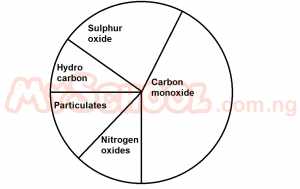Year :
2010
Title :
Geography
Exam :
JAMB Exam
Paper 1 | Objectives
31 - 40 of 49 Questions
| # | Question | Ans |
|---|---|---|
| 31. |
The population of Nigeria is estimated at? A. 124 million people B. 96 million people C. 162 million people D. 140 million people |
D |
| 32. |
Which of the following regions of Nigeria has heights of up to 1500 m above sea level? A. North Central Highland B. Western Highland C. Sokoto Plains D. Eastern Scarppland |
A |
| 33. |
The intra-city movement of passengers in most Nigerian towns is largely by? A. rail B. service buses C. taxis D. motorcycles |
B |
| 34. |
Which of the following is a major problem affecting the development of the Southern coast-lands of Nigeria? A. poor soil fertilty B. Oil pollution and spillage C. Ocean tides D. Hilly terrain of the area |
B |
| 35. |
An irrigation project in Nigeria devoted to sugarcane production cultivation is? A. Pategi B. Bakolori C. Numan D. Shonga |
B |
| 36. |
Which of the following factors mostly accounts for high population density in West Africa cities? A. Efficient transportation B. Concentration of industries C. Social amenties D. Administrative capital |
B |
| 37. |
In the equatorial region, most rainfall results from? A. conventional effect B. orographical effect C. harmattan winds D. cyclonic effect |
A |
| 38. |
Which of the following is a major mineral resource found in South Africa? A. Limestone B. Natural gas C. Copper D. Gold |
D |
| 39. |
The highlands that provide the sources of River Niger are? A. Plateau of Southern Mali and North Central Plateau of Nigeria B. Futa Djalon and Guinea Highlands C. Adamawa Highlands and Plateau of Southern Mali D. Mandara Mountains and Plateau |
B |
| 40. |
 What is the percentage of carbon monoxide in the atmosphere? A. 49% B. 51% C. 45% D. 47% |
C |
| 31. |
The population of Nigeria is estimated at? A. 124 million people B. 96 million people C. 162 million people D. 140 million people |
D |
| 32. |
Which of the following regions of Nigeria has heights of up to 1500 m above sea level? A. North Central Highland B. Western Highland C. Sokoto Plains D. Eastern Scarppland |
A |
| 33. |
The intra-city movement of passengers in most Nigerian towns is largely by? A. rail B. service buses C. taxis D. motorcycles |
B |
| 34. |
Which of the following is a major problem affecting the development of the Southern coast-lands of Nigeria? A. poor soil fertilty B. Oil pollution and spillage C. Ocean tides D. Hilly terrain of the area |
B |
| 35. |
An irrigation project in Nigeria devoted to sugarcane production cultivation is? A. Pategi B. Bakolori C. Numan D. Shonga |
B |
| 36. |
Which of the following factors mostly accounts for high population density in West Africa cities? A. Efficient transportation B. Concentration of industries C. Social amenties D. Administrative capital |
B |
| 37. |
In the equatorial region, most rainfall results from? A. conventional effect B. orographical effect C. harmattan winds D. cyclonic effect |
A |
| 38. |
Which of the following is a major mineral resource found in South Africa? A. Limestone B. Natural gas C. Copper D. Gold |
D |
| 39. |
The highlands that provide the sources of River Niger are? A. Plateau of Southern Mali and North Central Plateau of Nigeria B. Futa Djalon and Guinea Highlands C. Adamawa Highlands and Plateau of Southern Mali D. Mandara Mountains and Plateau |
B |
| 40. |
 What is the percentage of carbon monoxide in the atmosphere? A. 49% B. 51% C. 45% D. 47% |
C |